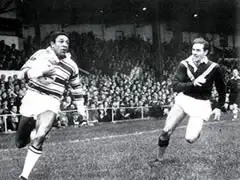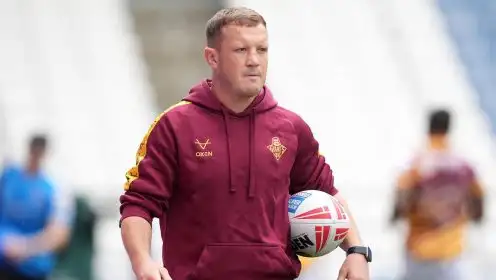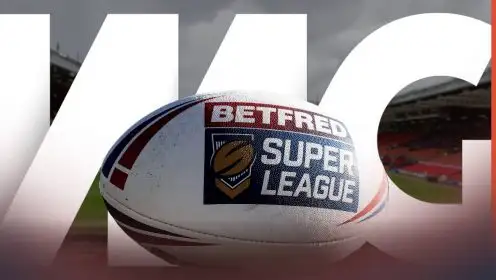Six Tackles: Welsh Legends of Rugby League

Colin Dixon
Sometimes overlooked in lists of Welsh RL legends, Dixon was a scrum-half and a centre, before finally blossoming in the second row as his strength and power grew. Born in Butetown, Cardiff, he was, like fellow Welsh league greats Gus Risman and Billy Boston, a product of South Church Street School in his hometown. Another victim of the unspoken racial prejudice which prevented many black and ethnic minority Welshman from winning caps in rugby union in the 1960s, Dixon thrived in the grittier surroundings of rugby league. He would go on to be a world record signing, at £12,000 plus a player worth £3000, when he joined Salford in 1968. A bruising forward, he was a part of the 1972 World Cup winning Great Britain side, and played 245 games for Halifax, 418 for Salford, and 25 for Hull KR. With 16 caps for Wales, and 14 for GB, Dixon is one of Welsh rugby league’s true heroes. He died in 1993 of a stroke, at the tragically young age of 49.
Jonathan Davies
With his slight build, curly mullet and permanently surprised looking eyes, ‘Jiffy’ was maybe not the accepted image of a rugby league player when he ‘came North’ in 1989, but he soon adapted to our game in style. Davies already had great hands, a superb boot and the ability to move through a gap at speed, as well as rugby intelligence in spades. But he added weight and strength to his body, too, and became one of the most famed converts to league. Everybody remembers his try for Great Britain in 1994 at Wembley, which helped the home team, reduced to 12-men, to a memorable 8-4 victory over Australia. He continues to offer this thoughts on the game, performing punditry and commentary duties for the BBC. He won 13 caps for Great Britain, scoring four tries. His three test match caps for Wales were won during the 1995 World Cup campaign, when he helped a Welsh team stuffed full of RU converts to the semi-finals.
Kevin Ellis
Ellis was a scrum-half who joined Warrington in 1990, after playing rugby union for Bridgend. Although not a Welsh RU international, Ellis had bags of potential, and thrived in primrose and blue, alongside greats such as Mike Gregory. He would go on to win 15 caps for Wales in the 13-man code between 1991 and 1994, and added one Great Britain cap, in 1991, against France. He toured with the GB Lions in 1992. He has also done some sterling development work in his home country, with Brynteg School former pupils Rhys and Ben Evans amongst the players he has inspired. In 2010 he won the Mike Gregory Award for his work in development in South Wales, and he remains a keen advocate for rugby league in a country where RU, although tottering at grassroots level, remains king for now.
Jim Mills
One of the game’s real hardmen, ‘Big Jim’, famously had his ‘eyes of blue’ to accompany his 18 stone miner’s build. This Aberdare native is an icon in Widnes. Mills began his rugby career playing RU in Cardiff, before joining Halifx in 1965. He would move to Widnes in 1968, and it was there that he would establish himself as one of rugby league’s most fearsome forwards. He would win six test caps for Great Britain, and play five times for Wales. Although his stamp on the head of Kiwi John Greengrass at Swansea in 1975 is remembered by some, his brutal effectiveness and rough-hewn charisma is recalled with affection by far more, especially by fans who wear black and white. Mills has also managed the Wales national team.
Billy Boston
A true icon of the sport, especially in Wigan, Billy Boston’s career followed a typical trajectory for a Welshman from his background. A native of Tiger Bay, Cardiff. His mother had Irish roots, while his father was a sailor from Sierra Leone. Always big for a three-quarter, he weighed 15 pounds when he was born. Frustration with a lack of progress in rugby union saw him come North. He said: “I was disappointed that Cardiff never showed any interest in me and I think that was because of my colour. They certainly wouldn’t let me into their clubhouse after I turned professional. I don’t think I would ever have been picked for Wales at union.” Union’s loss was league’s massive gain, however, when Boston signed for Wigan in 1953. He would go on to win 31 caps for Great Britain, scoring 24 tries. He also played two games for the Other Nationalities, and one game for a Welsh XIII. He would leave Wigan in 1968 and play one season for Balckbool Borough before his retirement in 1970.
Clive Sullivan
Boston’s status in Wigan is matched by that of Clive Sullivan in the city of Hull, where the main route into the town, the A63, is named Clive Sullivan Way after the great winger. Born in Cardiff, Sullivan’s childhood operations on knees, feet and shoulders made it seem unlikely he would ever play rugby. In the army in 1961, however, he played a game of rugby union, and showed his immense talent. He signed for Hull FC in 1961, but his career did not really blossom until he left the Army in 1964. He scored 250 tries for the Airlie Birds in 352 games, before joining Hull KR in 1974. He would repeat his amazing feats with the Robins, notching 118 tries in 213 games. Sullivan was the first black captain of any British national team, and remains the only Welsh skipper to ever lift a World Cup in any sport, when he helped GB to win the World Cup in 1972, scoring a memorable try in the decisive match against Australia. His 17 caps and 13 tries for GB are complemented by 15 caps for Wales, for whom he scored seven tries. He died in 1985 of cancer, aged just 42.



